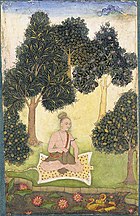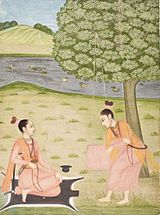Yoga
The origins of yoga have been speculated to date back to pre-Vedic Indian traditions; it is mentioned in the Rigveda,[note 1] but most likely developed around the sixth and fifth centuries BCE,[8] in ancient India's ascetic and śramaṇa movements.[9][note 2] The chronology of earliest texts describing yoga-practices is unclear, varyingly credited to Hindu Upanishads.[10] The Yoga Sutras of Patanjali date from the first half of the 1st millennium CE,[11][12] but only gained prominence in the West in the 20th century.[13] Hatha yoga texts emerged around the 11th century with origins in tantra.[14][15]
Yoga gurus from India later introduced yoga to the West,[16] following the success of Swami
Vivekananda in the late 19th and early 20th century.[16] In the 1980s, yoga became popular as a system of physical exercise across the Western world.[15] Yoga in Indian traditions, however, is more than physical exercise; it has a meditative and spiritual core.[17] One of the six major orthodox schools of Hinduism is also called Yoga, which has its own epistemology and metaphysics, and is closely related to Hindu Samkhya philosophy.[18]
Many studies have tried to determine the effectiveness of yoga as a complementary intervention for cancer, schizophrenia, asthma, and heart disease.[19][20] The results of these studies have been mixed and inconclusive.[19][20] On December 1, 2016, yoga was listed by UNESCO as an Intangible cultural heritage.[21]
Sumber: Google



Tidak ada komentar:
Posting Komentar